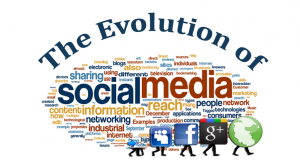The Evolution of Social Media, From BBS to Momo
We hear the concerns all the time, “social media is ruining the world,” “children no longer interact face-to-face thanks to social media,” and the latest one, which can simply be referred to as the “Momo Challenge”.
Merriam-Webster’s definition of ‘social media’ explains it plainly as, “forms of electronic communication through which users create online communities to share information, ideas, personal messages and other content.” While some may think social media is a new concept, with applications such as Facebook, Instagram, YouTube, Snapchat, Whatsapp and Twitter taking over our lives, social media has actually been around for almost 30 years now. 
Take a trip back with me, to the early 90s. While that may not seem like a long time ago to some, it was a lifetime ago in the evolution of social media. The BBS, or bulletin board system, was making waves in young people’s lives all over. What, there’s a way to get on the computer and talk to your friends without ever leaving the house? And the GUI-based interface provided an added bonus of anonymity through keyboard and screen. Life changing!
Now enters the ever-glorious world of dial-up modems and actual web browsers. Internet at home exploded, and so did social media. The age of AOL gave birth to sites like SixDegrees.com, Blogger and Friendster. As the internet evolved and became more present in homes, the big ones like MySpace and Facebook jumped to the forefront.
Fast forward to around 2010, and social media takes its biggest leap yet. Smartphones and tablets. You no longer had to sit at your computer at home or work to check on those thriving social media sites. You could simply pull out your phone and connect to people from all over the world. Feeling a little down and need a little validation? Update that status and you’ll have messages flying in!
As access to smart devices and Wi-Fi have increased, the average age of those engaging in social media has most definitely decreased. The term ‘screen time’ no longer applies to monitored cartoons on the television. Screen time is now an open world of endless opportunities to view images, videos and thoughts from others all over the world. Unfortunately, with that access comes some downfalls. And the worst part? We are the only ones that can regulate and monitor what we allow ourselves and our children to be exposed to.
While social media may not be a new concept, the convenience of it in our lives is only growing daily. Want to check the menu for a restaurant you’re heading to this weekend? Well, you’re going to have to look at their Facebook page. Oh wait, what’s that in my newsfeed? I better read this, first. Want to get some dishes done or simply enjoy a little peace and quiet? Set the kids up with a little YouTube, and they’ll stay busy for hours. See? Convenience.
While there are pluses and minuses to social media, the minuses are usually the ones we outwardly focus on. Our relationship with status updates, watching uploaded videos and viewing images from all over the world is a love/hate one, at best. The access we now have to information is unbelievable, but we are still in a transitional period. Many of us remember how life was BEFORE social media. We remember what it felt like to live in our sheltered bubbles of information intake. We have something to compare this new world to. The children in our lives, however, have no concept of that world. And they most likely never will. Is this a bad thing? Not if we don’t make it one.
Children on social media has been a pretty prominent topic in the news, lately. If you have access to the internet at all (which I’m assuming you do since you are reading this) you have seen this ‘Momo Challenge’ craze. As a parent, I was quite surprised when this image started popping up in my own social media newsfeeds. Especially since my kids had already shown me a YouTube video about the urban legend of Momo, last summer.
Every time one of these fear-inducing viral hoaxes explode on the internet, the first reaction you see is the bashing of social media. However, hoaxes have been around for as long as humans have been around. P.T. Barnum didn’t need social media to gain notoriety for the Cardiff Giant. Now that we have constant information flowing from our smart devices to our hands and into our heads, we are much more susceptible to false information. While it is unfortunate, it also gives us plenty of learning and teaching moments in a fast-paced and dynamic modern world.
There’s a reason the saying, “Don’t believe everything you read on the internet” came about. Remember the definition of social media, “users create online communities to share information, ideas, personal messages and other content.” Social media provides a platform for shared information. It is not always a source of factual information.
As adults, we need to remember to help the younger generation with this concept. While they will most likely have a much better understanding on how to sift through facts and falsehoods than we ever will by the time they are adults, they need us now. They need us to help create a healthier social media environment. Don’t create fear where fear is not necessary. Talk to them and ask them questions. The internet is not going anywhere any time soon, and this is their reality. And if you’re still not comfortable with what their curious minds are taking in, then check that YouTube history. Whatever makes you feel confident enough to give them the support and guidance they need, do it.
And the next time you start telling yourself that social media is ruining the world, think back to those BBS chat forums and Friendster. The information being shared online comes simply from a person with a keyboard and connection. You get to choose what you allow to enter your world.








